Application Study of Empirical Wavelet Transform in Time–Frequency Analysis of Electromagnetic Radiation Induced by Rock Fracture
Abstract
1. Introduction
2. EWT Theory
- (1)
- Fourier axis segmentation
- (2)
- Construction of Meyer wavelet filter
- (3)
- Signal decomposition and reconstruction
3. Adaptive Segmentation Method of Fourier Axis
3.1. Conventional Segmentation Method of Fourier Axis
3.2. An Improved Adaptive Segmentation Method of Fourier Axis
3.2.1. Closing Operation Theory
3.2.2. Adaptive Selection of Window Width of the Closing Operation
3.2.3. Adaptive Determination of Segment Number of Fourier Axis
3.2.4. Decomposition of EMR Waveform
3.2.5. Fourier Axis Segmentation Based on STFT and Closing Operation
4. EWT–HT Application in Time–Frequency Analysis for EMR Waveform of Rock Fracture
4.1. Experimental System
4.2. Response of EMR Signal on Rock Fracture
4.3. Time–Frequency Analysis for EMR Waveform
5. Discussion
6. Conclusions
- (1)
- The window width of the closing operation is one of the keys to Fourier axis segmentation, and it can be selected based on the drawing frequency resolution, the sampling frequency, and the number of sampling points of the waveform. The threshold value to detect the effective maxima can be determined by the adaptive ratio α.
- (2)
- Based on the Fourier axis obtained by STFT, where the short–time and high–amplitude components existing in the EMR waveform are well extracted, the Fourier axis segmentation is more effective than that directly based on DFT.
- (3)
- EWT–HT overcomes the modal aliasing of HHT and the inability of STFT to take into account the resolution in both the time and frequency domains. It can well describe the time–frequency evolution characteristics of the EMR waveform induced by rock fracture.
Author Contributions
Funding
Conflicts of Interest
References
- Zhao, Y.; Jiang, Y. Acoustic emission and thermal infrared precursors associated with bump-prone coal failure. Int. J. Coal Geol. 2010, 83, 11–20. [Google Scholar] [CrossRef]
- Ma, L.; Sun, H.; Zhang, Y.; Zhou, T.; Li, K.; Guo, J. Characteristics of Infrared Radiation of Coal Specimens Under Uniaxial Loading. Rock Mech. Rock Eng. 2016, 49, 1567–1572. [Google Scholar] [CrossRef]
- Frid, V.; Wang, E.Y.; Mulev, S.N.; Li, D.X. The fracture induced electromagnetic radiation: Approach and protocol for the stress state assessment for mining. Geotech. Geol. Eng. 2021, 39, 3285–3291. [Google Scholar] [CrossRef]
- Sharma, S.K.; Chauhan, V.S.; Sinapius, M. A review on deformation-induced electromagnetic radiation detection: History and current status of the technique. J. Mater. Sci. 2021, 56, 4500–4551. [Google Scholar] [CrossRef]
- Romanevich, K.V.; Lebedev, M.O.; Andrianov, S.V.; Mulev, S.N. Integrated Interpretation of the Results of Long-Term Geotechnical Monitoring in Underground Tunnels Using the Electromagnetic Radiation Method. Foundations 2022, 2, 561–580. [Google Scholar] [CrossRef]
- Qiu, L.; Li, Z.; Wang, E.; Liu, Z.; Ou, J.; Li, X.; Ali, M.; Zhang, Y.; Xia, S. Characteristics and precursor information of electromagnetic signals of mining-induced coal and gas outburst. J. Loss Prev. Process Ind. 2018, 54, 206–215. [Google Scholar] [CrossRef]
- Das, S.; Mallik, J.; Bandyopadhyay, K.; Das, A. Evaluation of maximum horizontal near-surface stress (SHmax) azimuth and its distribution along Narmada-Son Lineament, India by geogenic Electromagnetic Radiation (EMR) technique. J. Geodyn. 2020, 133, 101672. [Google Scholar] [CrossRef]
- Zhou, C.H.; Li, Y.A.; Yin, J.M.; Wang, Y.; Zhou, C.; Guo, X. Multivariate early warning method for rockbursts based on comprehensive microseismic and electromagnetic radiation monitoring. Chin. J. Geotech. Eng. 2020, 42, 457–466. [Google Scholar]
- Song, D.; Wang, E.; He, X.; Jia, H.; Qiu, L.; Chen, P.; Wang, S. Use electromagnetic radiation from fractures for mining-induced stress field assessment. J. Geophys. Eng. 2018, 15, 1093–1103. [Google Scholar] [CrossRef]
- Wang, E.; He, X.; Liu, X.; Xu, W. Comprehensive monitoring technique based on electromagnetic radiation and its applications to mine pressure. Saf. Sci. 2012, 50, 885–893. [Google Scholar] [CrossRef]
- Di, Y.; Wang, E. Rock burst precursor electromagnetic radiation signal recognition method and early warning application based on recurrent neural networks. Rock Mech. Rock Eng. 2021, 54, 1449–1461. [Google Scholar] [CrossRef]
- Yin, S.; Song, D.; Li, J.; He, X.; Qiu, L.; Lou, Q.; Wei, M.; Liu, Y. Research on electromagnetic radiation (EMR) waveform characteristics of coal failure process using Hilbert-Huang transform (HHT). Measurement 2022, 187, 110195. [Google Scholar] [CrossRef]
- Wang, H.; Wang, E.; Li, Z.; Shen, R.; Liu, X.; Gao, X.; Li, B.; Zhang, Q. Study on safety pressure of water jet breaking coal based on the characteristic analysis of electromagnetic radiation signal. Process Saf. Environ. Prot. 2020, 144, 284–296. [Google Scholar] [CrossRef]
- Qiu, L.; Liu, Z.; Wang, E.; Li, B. Early-warning of rock burst in coal mine by low-frequency electromagnetic radiation. Eng. Geol. 2020, 279, 105755. [Google Scholar] [CrossRef]
- Frid, V.; Rabinovitch, A.; Bahat, D. Fracture induced electromagnetic radiation. J. Phys. D Appl. Phys. 2003, 36, 1620–1628. [Google Scholar] [CrossRef]
- Frid, V.; Bahat, D.; Goldbaum, J.; Rabinovitcha, A. Experimental and theoretical investigations of electromagnetic radiation induced by rock fracture. Isr. J. Earth Sci. 2000, 49, 9–19. [Google Scholar]
- Rabinovitch, A.; Frid, V.; Bahat, D. Surface oscillations—A possible source of fracture induced electromagnetic radiation. Tectonophysics 2007, 431, 15–21. [Google Scholar] [CrossRef]
- Li, X.B.; Wan, G.X.; Zhou, Z.L. The relation between the frequency of electromagnetic radiation (EMR) induced by rock fracture and attribute parameters of rock masses. Chin. J. Geophys. 2009, 52, 253–259. (In Chinese) [Google Scholar]
- Song, D.; Wang, E.; Song, X.; Jin, P.; Qiu, L. Changes in frequency of electromagnetic radiation from loaded coal rock. Rock Mech. Rock Eng. 2016, 49, 291–302. [Google Scholar] [CrossRef]
- Wei, M.; Song, D.; He, X.; Li, Z.; Qiu, L.; Lou, Q. Effect of rock properties on electromagnetic radiation characteristics generated by rock fracture during uniaxial compression. Rock Mech. Rock Eng. 2020, 53, 5223–5238. [Google Scholar] [CrossRef]
- Loh, C.H.; Wu, T.C.; Huang, N.E. Application of the empirical mode decomposition-Hilbert spectrum method to identify near-fault ground-motion characteristics and structural responses. Bull. Seismol. Soc. Am. 2001, 91, 1339–1357. [Google Scholar] [CrossRef]
- Carpinteri, A.; Lacidogna, G.; Manuello, A.; Niccolini, G.; Schiavi, A.; Agosto, A. Mechanical and electromagnetic emissions related to stress-induced cracks. Exp. Tech. 2012, 36, 53–64. [Google Scholar] [CrossRef]
- Kong, B.; Wang, E.; Li, Z.; Wang, X.; Liu, X.; Li, N.; Yang, Y. Electromagnetic radiation characteristics and mechanical properties of deformed and fractured sandstone after high temperature treatment. Eng. Geol. 2016, 209, 82–92. [Google Scholar] [CrossRef]
- Qiu, L.; Zhu, Y.; Song, D.; He, X.; Wang, W.; Liu, Y.; Xiao, Y.; Wei, M.; Yin, S.; Liu, Q. Study on the nonlinear characteristics of EMR and AE during coal splitting tests. Minerals 2022, 12, 108. [Google Scholar] [CrossRef]
- Yin, S.; Song, D.; He, X.; Qiu, L.; Wei, M.; Wang, C.; Chen, Y.; Li, P.; Li, J. Time-frequency evolution law and generation mechanism of electromagnetic radiation in coal friction process. Eng. Geol. 2021, 294, 106377. [Google Scholar] [CrossRef]
- Sejdić, E.; Djurović, I.; Jiang, J. Time-frequency feature representation using energy concentration: An overview of recent advances. Digit. Signal Process. 2009, 19, 153–183. [Google Scholar] [CrossRef]
- Han, J.; Huang, S.; Zhao, W.; Wang, S. Stress excited electrical dipole model for electromagnetic emission induced in fractured rock. Int. J. Appl. Electrom. 2016, 52, 1023–1034. [Google Scholar] [CrossRef]
- Huang, N.E.; Shen, Z.; Long, S.R.; Wu, M.C.; Shih, H.H.; Zheng, Q.; Yen, N.C.; Tung, C.C.; Liu, H.H. The empirical mode decomposition and the Hilbert spectrum for nonlinear and non-stationary time series analysis. Proc. R. Soc. Lond. Ser. A Math. Phys. Eng. Sci. 1998, 454, 903–995. [Google Scholar] [CrossRef]
- Zhang, S.; Sun, X.; Li, C.; Xu, X.; Xiong, Z. The analysis of coal or rock electromagnetic radiation (EMR) signals based on Hilbert-Huang transform (HHT). Procedia Eng. 2011, 26, 689–698. [Google Scholar]
- Huang, N.E.; Wu, M.L.C.; Long, S.R.; Shen, S.S.P.; Qu, W.; Gloersen, P.; Fan, K.L. A confidence limit for the empirical mode decomposition and Hilbert spectral analysis. Proc. R. Soc. A Math. Phys. Eng. Sci. 2003, 459, 2317–2345. [Google Scholar] [CrossRef]
- Dätig, M.; Schlurmann, T. Performance and limitations of the Hilbert-Huang transformation (HHT) with an application to irregular water waves. Ocean Eng. 2004, 31, 1783–1834. [Google Scholar] [CrossRef]
- Wu, Z.; Huang, N.E. Ensemble empirical mode decomposition: A noise-assisted data analysis method. Adv. Adapt. Data Anal. 2009, 1, 1–41. [Google Scholar] [CrossRef]
- Gilles, J. Empirical wavelet transform. IEEE Trans. Signal Process. 2013, 61, 3999–4010. [Google Scholar] [CrossRef]
- Thirumala, T.; Umarikar, A.C.; Jain, T. Estimation of single-phase and three-phase power-quality indices using empirical wavelet transform. IEEE Trans. Power Deliv. 2015, 30, 445–454. [Google Scholar] [CrossRef]
- Bhattacharyya, A.; Pachori, R.B. A multivariate approach for patient-specific EEG seizure detection using empirical wavelet transform. IEEE Trans. Biomed. Eng. 2017, 64, 2003–2015. [Google Scholar] [CrossRef]
- Li, J.; Li, Y.; Li, Y.; Qian, Z. Downhole microseismic signal denoising via empirical wavelet transform and adaptive thresholding. J. Geophys. Eng. 2018, 15, 2469–2480. [Google Scholar] [CrossRef]
- Zhang, Q.; Ding, J.; Zhao, W. An adaptive boundary determination method for empirical wavelet transform and its application in wheelset-bearing fault detection in high-speed trains. Measurement 2021, 171, 108746. [Google Scholar] [CrossRef]
- Soille, P. Morphological Image Analysis: Principles and Applications, 2nd ed.; Springer: Berlin/Heidelberg, Germany, 2004. [Google Scholar]
- Yang, W.; Li, D.; Zhu, L.; Kang, Y.; Li, F. A new approach for image processing in foreign fiber detection. Comput. Electron. Agr. 2009, 68, 68–77. [Google Scholar] [CrossRef]
- Lou, Q.; Song, D.; He, X.; Li, Z.; Qiu, L.; Wei, M.; He, S. Correlations between acoustic and electromagnetic emissions and stress drop induced by burst-prone coal and rock fracture. Saf. Sci. 2019, 115, 310–319. [Google Scholar] [CrossRef]
- Fukui, K.; Okubo, S.; Terashima, T. Electromagnetic radiation from rock during uniaxial compression testing: The effects of rock characteristics and test conditions. Rock Mech. Rock Eng. 2005, 38, 411–423. [Google Scholar] [CrossRef]
- Carpinteri, A.; Lacidogna, G.; Borla, O.; Manuello, A.; Niccolini, G. Electromagnetic and neutron emissions from brittle rocks failure: Experimental evidence and geological implications. Sadhana 2012, 37, 59–78. [Google Scholar] [CrossRef]
- Yin, S.; Song, D.; He, X.; Lou, Q.; Qiu, L.; Li, Z.; Peng, C.; Li, J.; Liu, Y. Structural health monitoring of building rock based on stress drop and acoustic-electric energy release. Struct. Control Health Monit. 2022, 29, e2875. [Google Scholar] [CrossRef]
- Zhao, F.; Li, Y.; Ye, Z.; Fan, Y.; Zhang, S.; Wang, H.; Liu, Y. Research on Acoustic Emission and Electromagnetic Emission Characteristics of Rock Fragmentation at Different Loading Rates. Shock Vib. 2018, 2018, 4680879. [Google Scholar] [CrossRef]
- Triantis, D.; Pasiou, E.D.; Stavrakas, I.; Kourkoulis, S.K. Hidden Affinities Between Electric and Acoustic Activities in Brittle Materials at Near-Fracture Load Levels. Rock Mech. Rock Eng. 2022, 55, 1325–1342. [Google Scholar] [CrossRef]
- Triantis, D.; Vallianatos, F.; Stavrakas, I.; Hloupis, G. Relaxation phenomena of electrical signal emissions from rock following application of abrupt mechanical stress. Ann. Geophys. 2012, 55, 207–212. [Google Scholar] [CrossRef]
- Kourkoulis, S.K.; Pasiou, E.D.; Loukidis, A.; Stavrakas, I.; Triantis, D. Comparative Assessment of Criticality Indices Extracted from Acoustic and Electrical Signals Detected in Marble Specimens. Infrastructures 2022, 7, 15. [Google Scholar] [CrossRef]
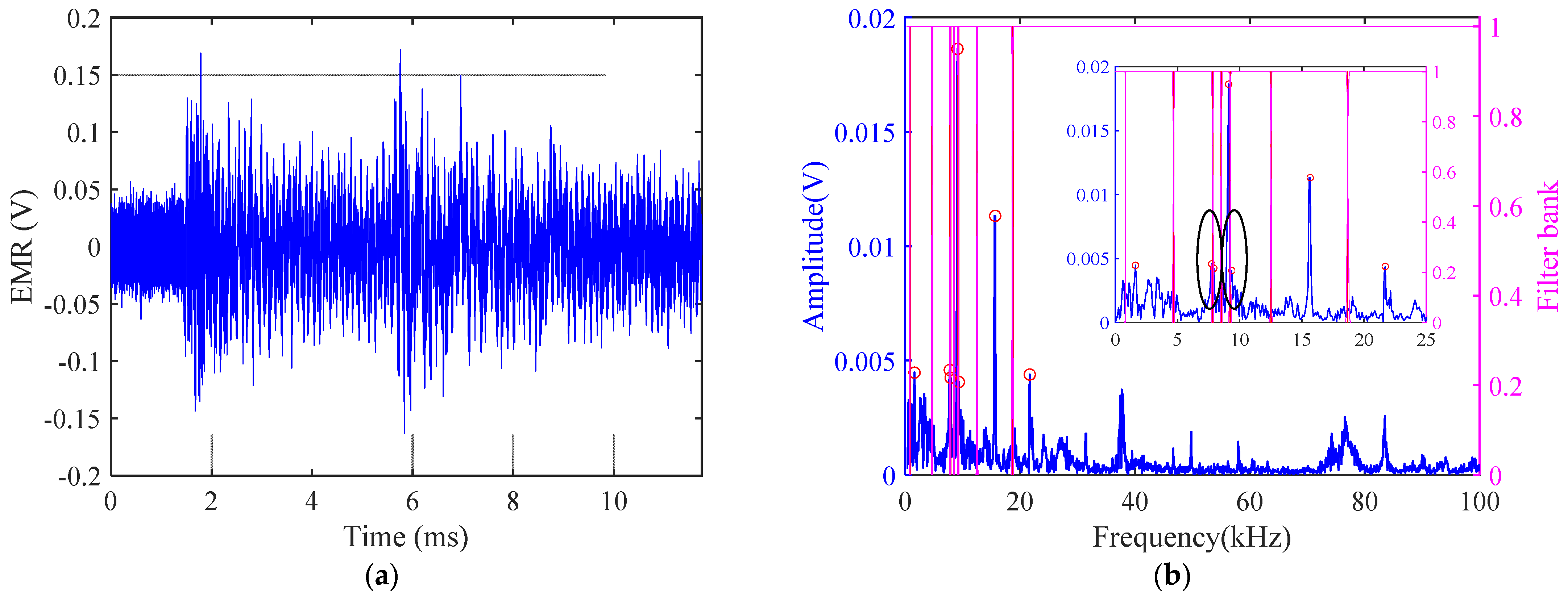
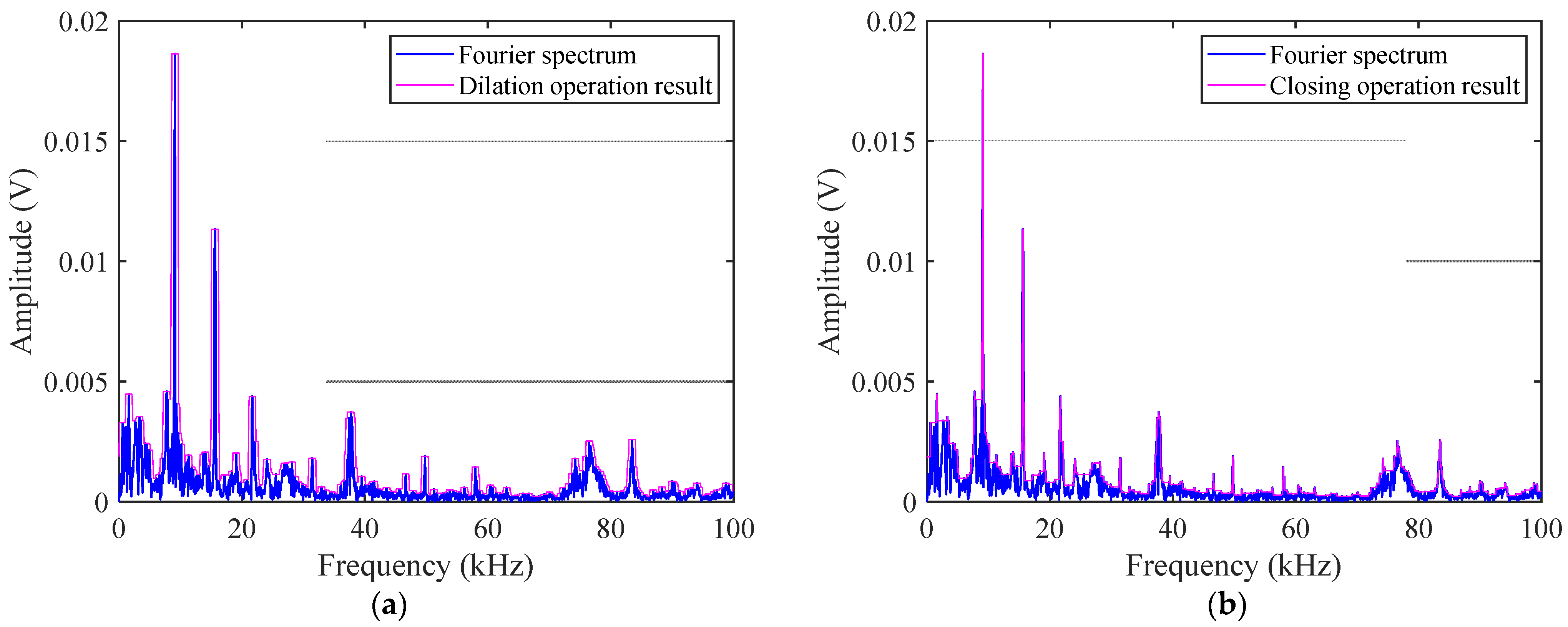
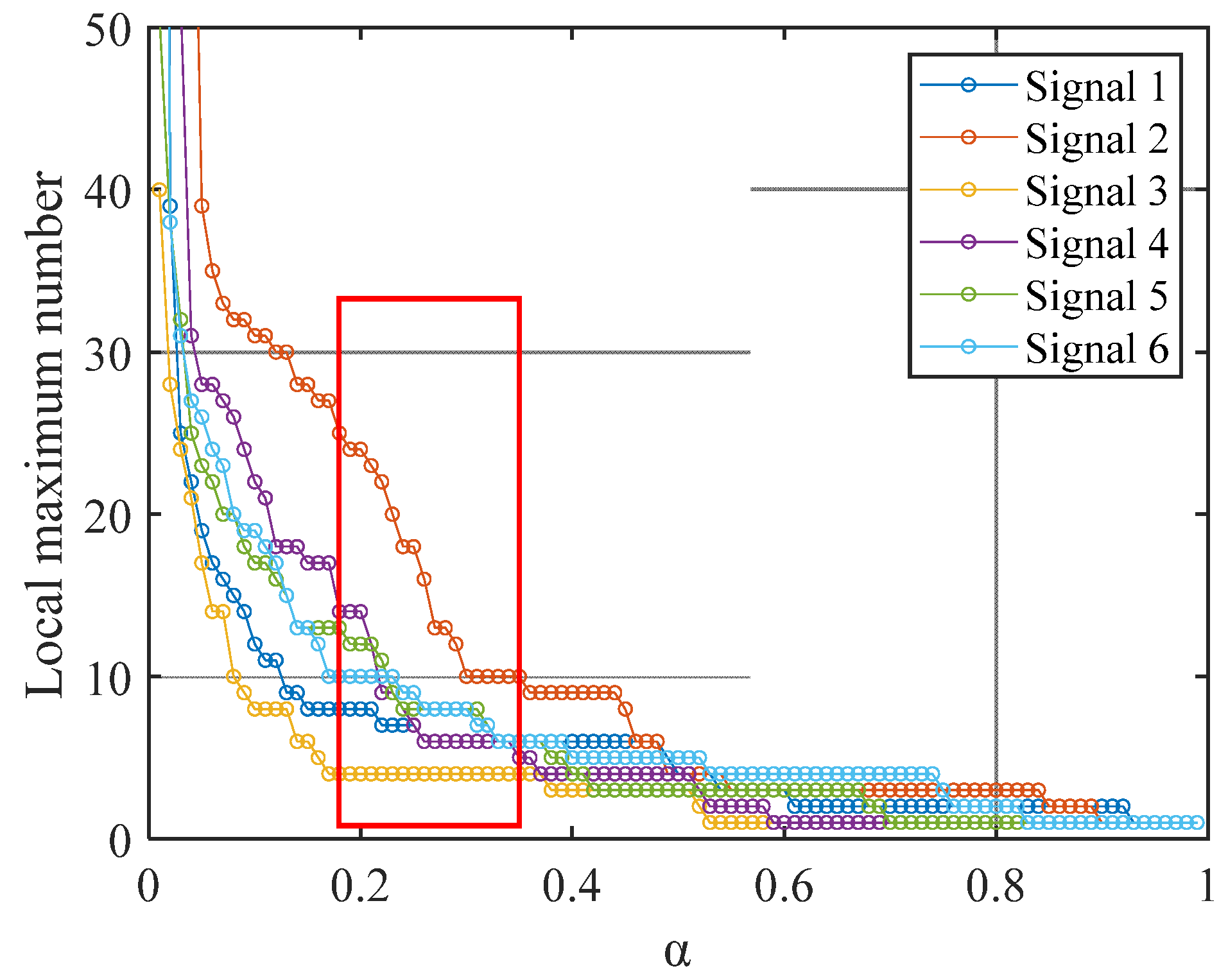
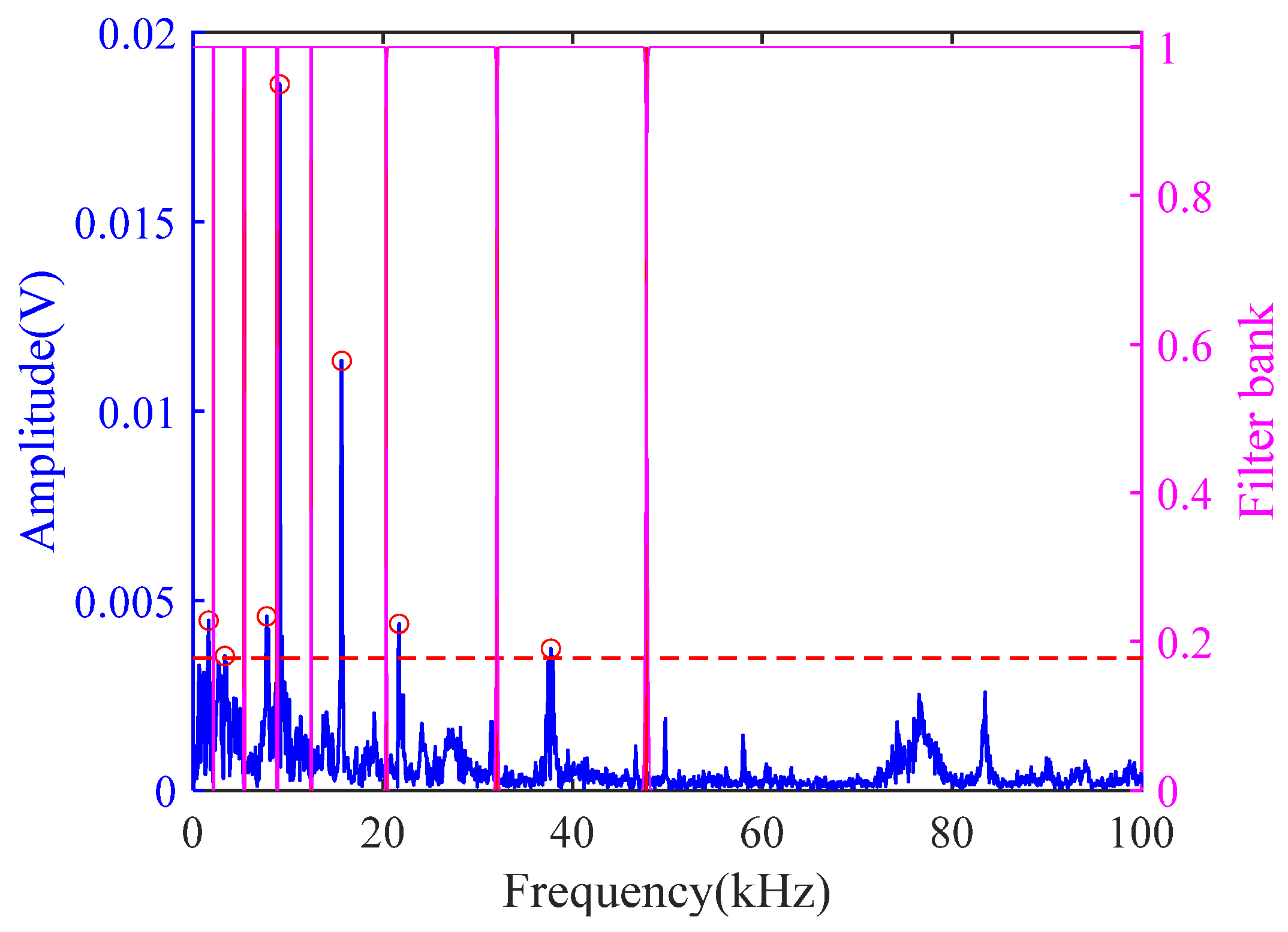
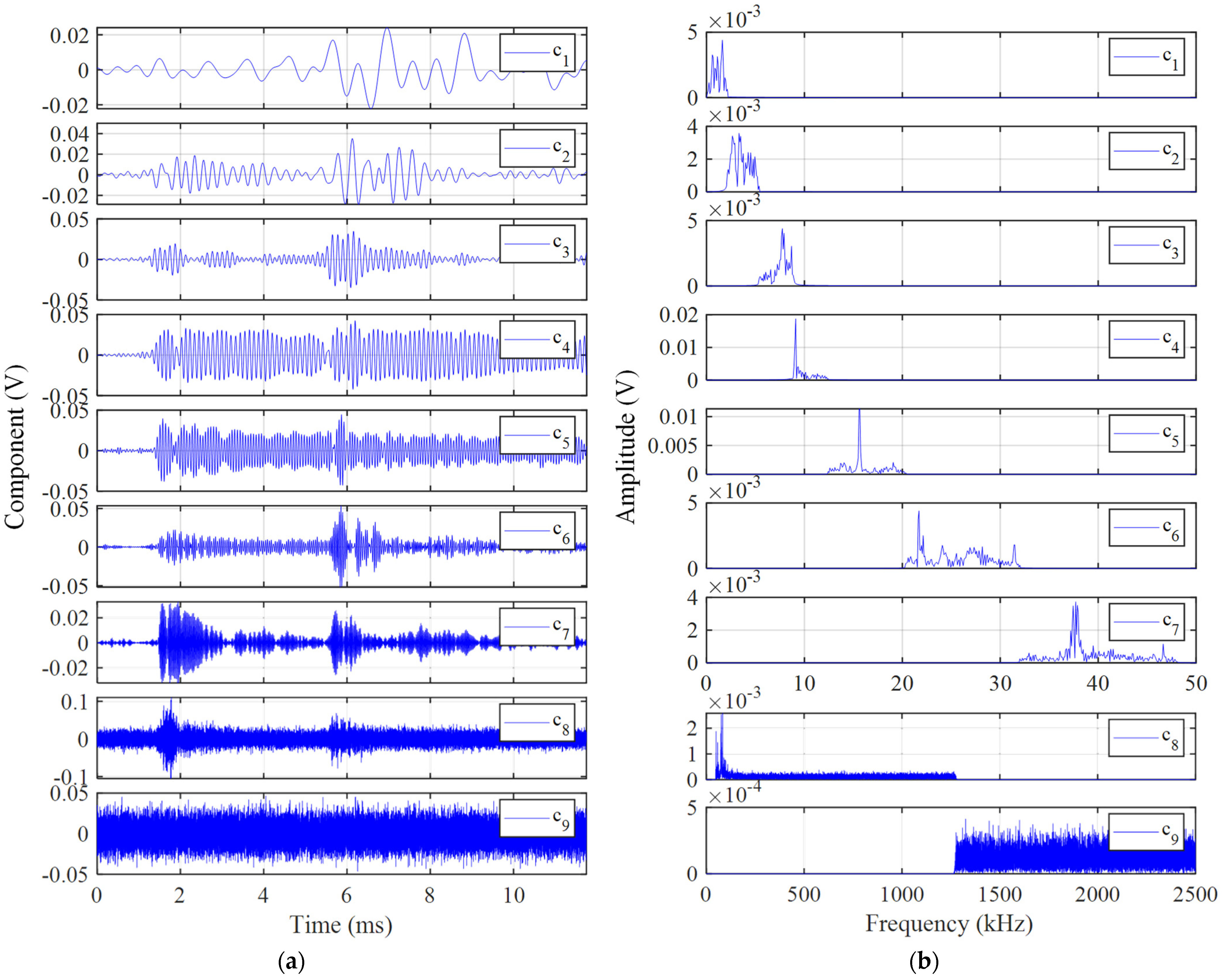
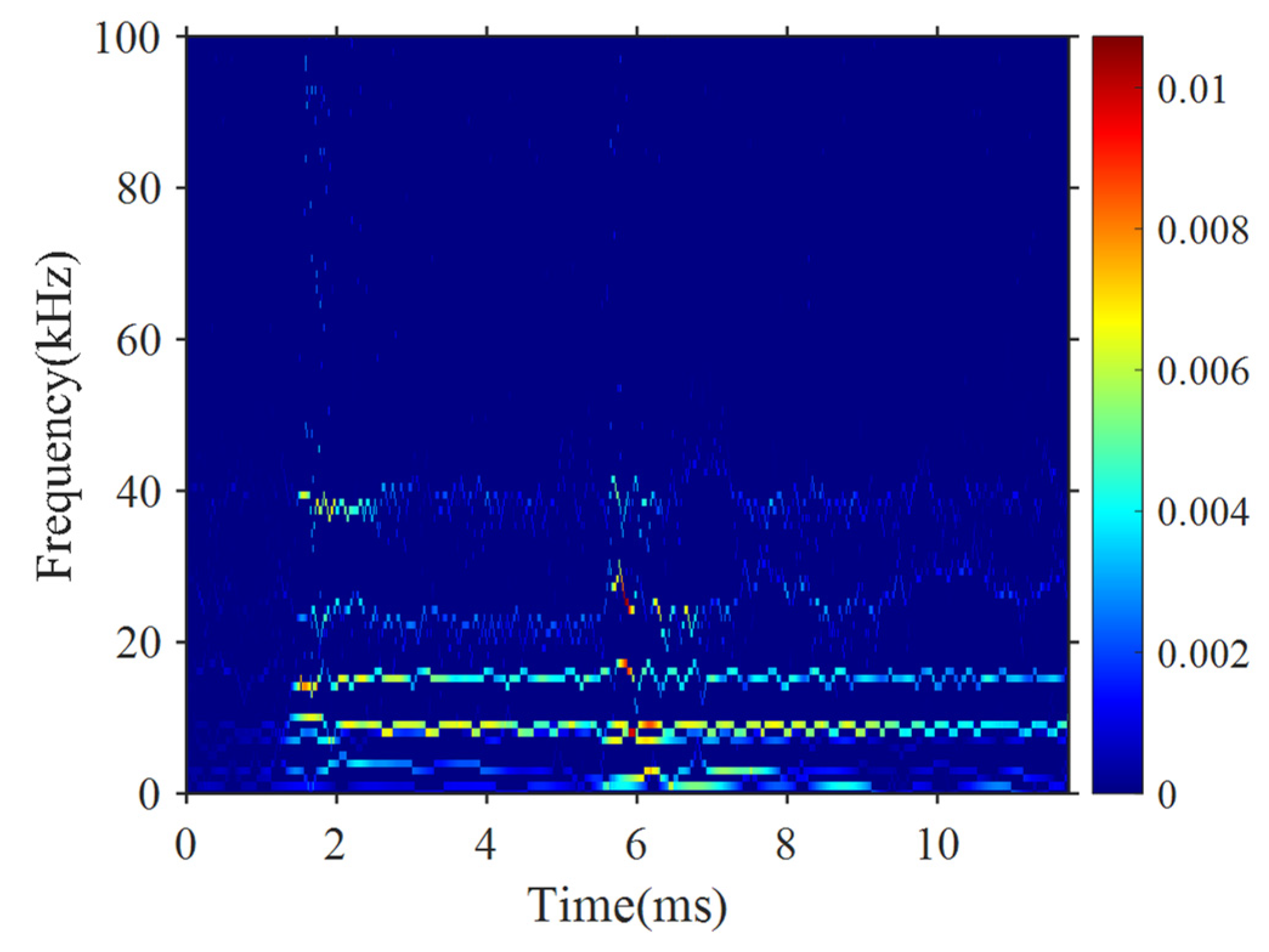
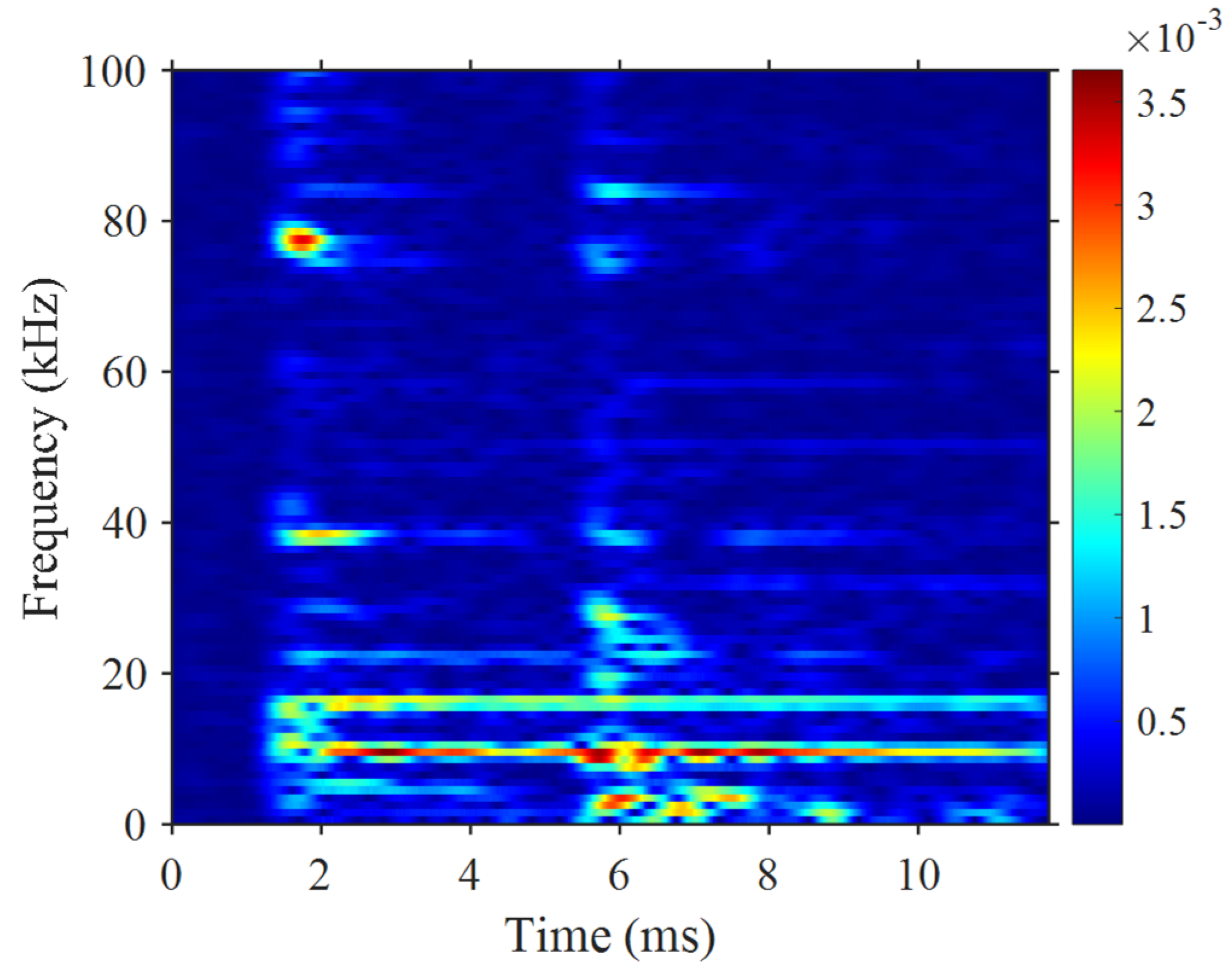
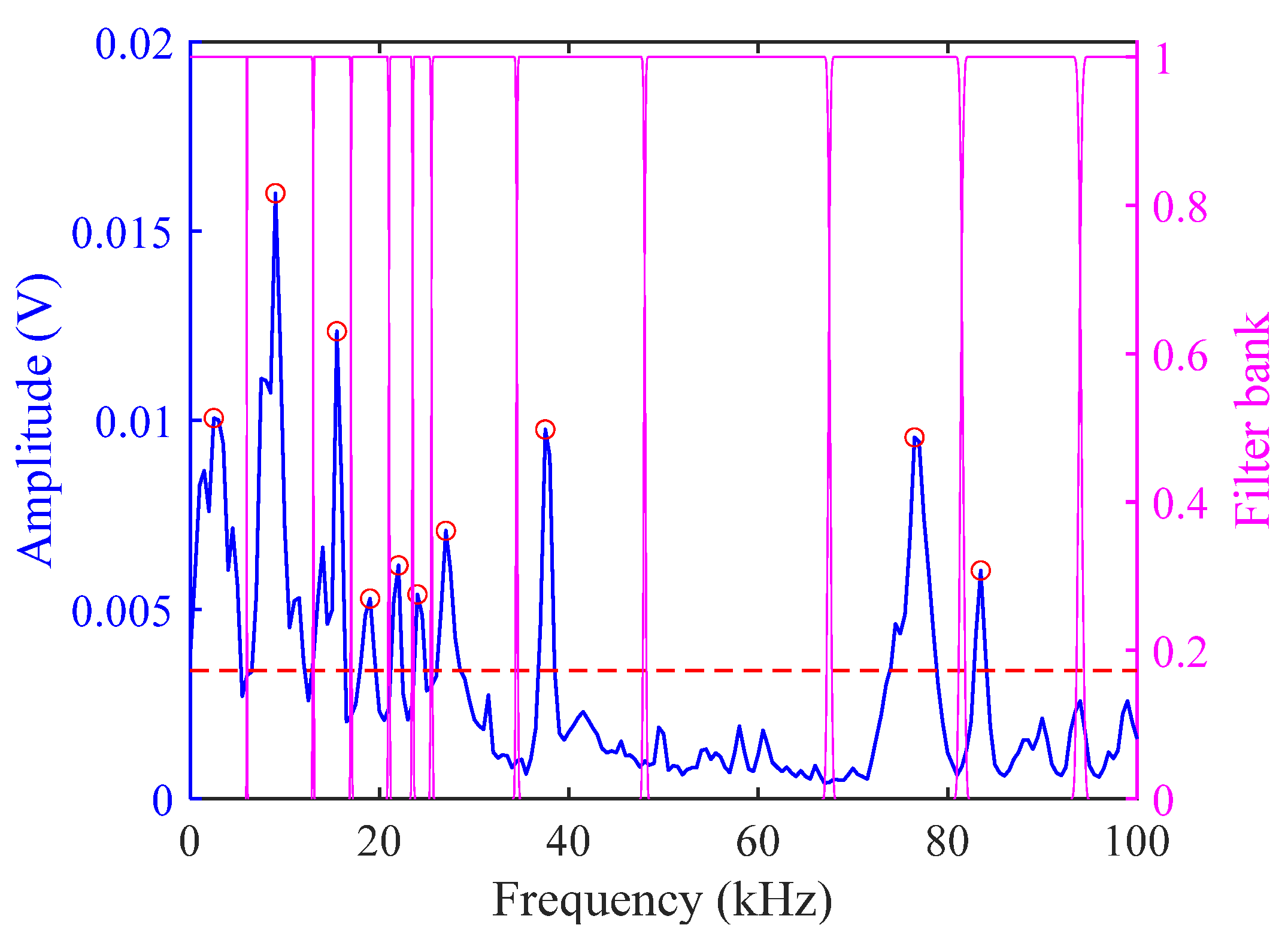
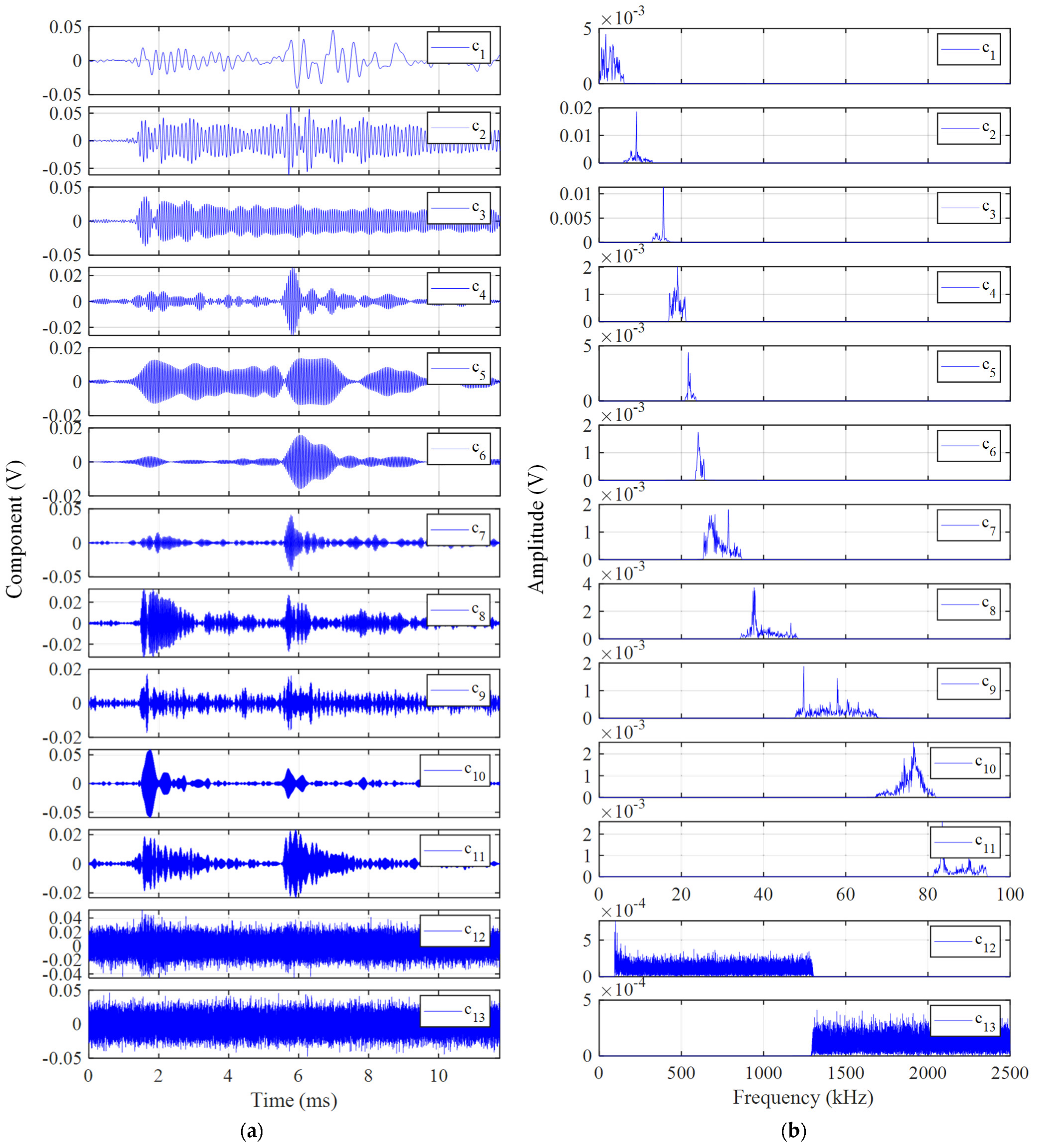
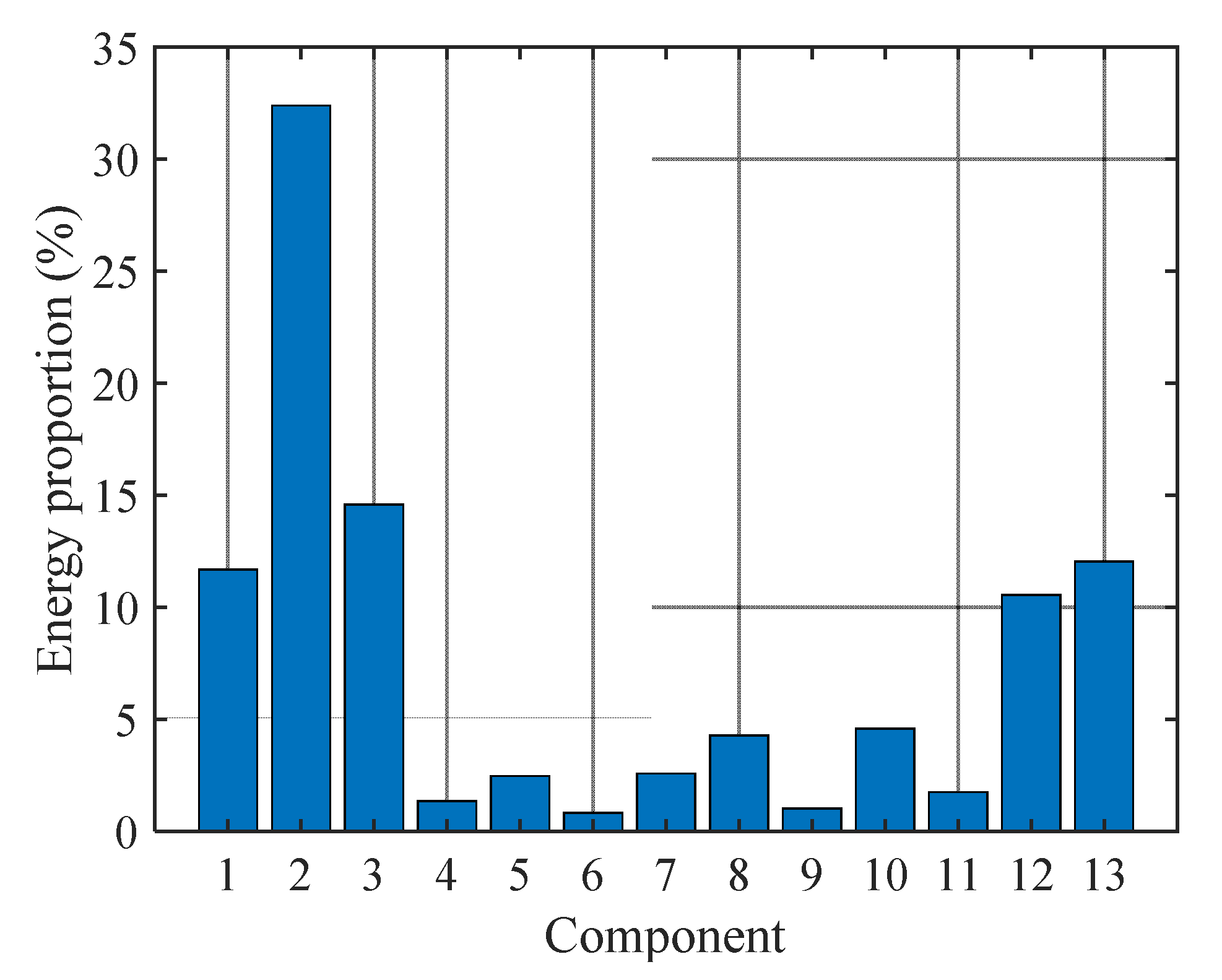
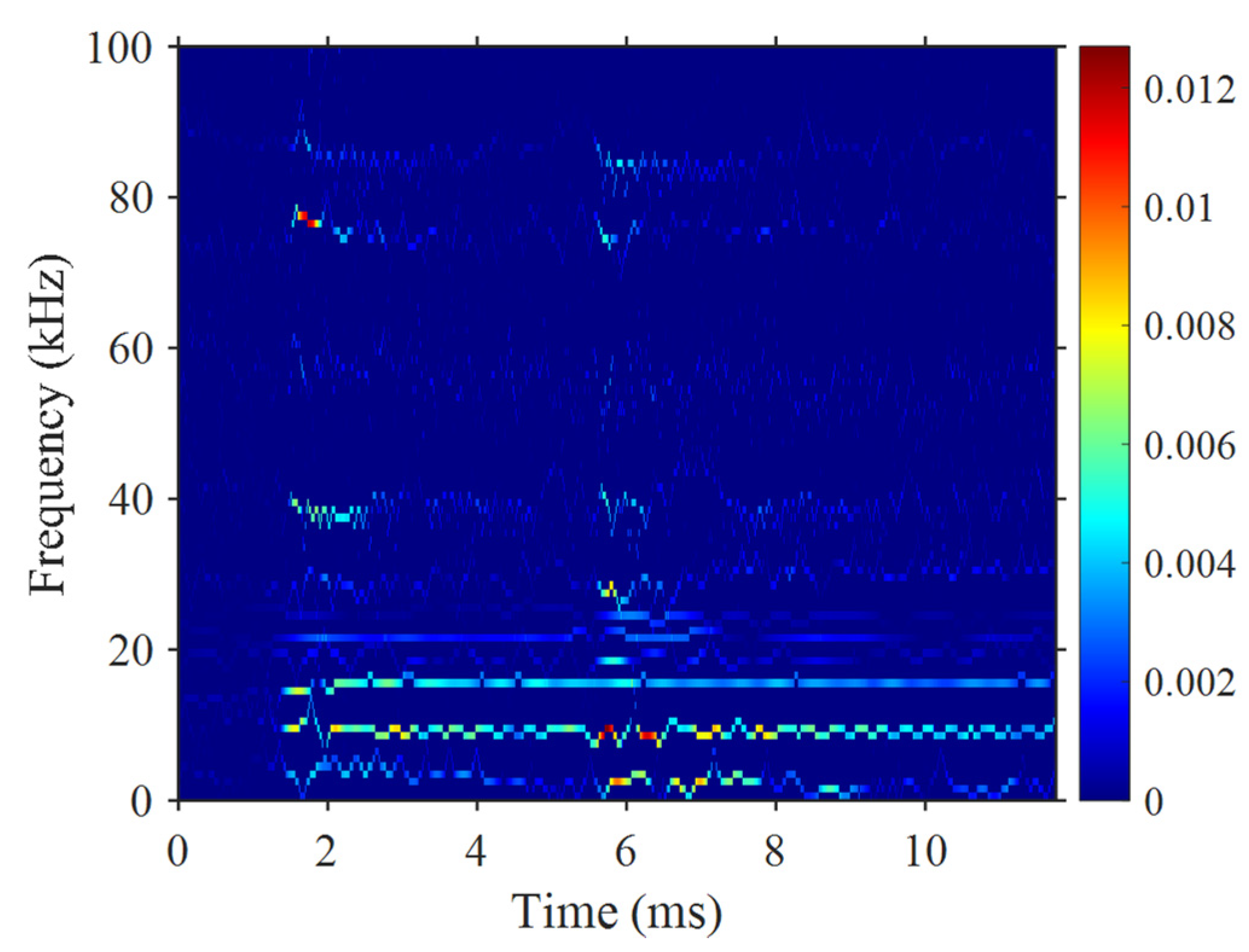
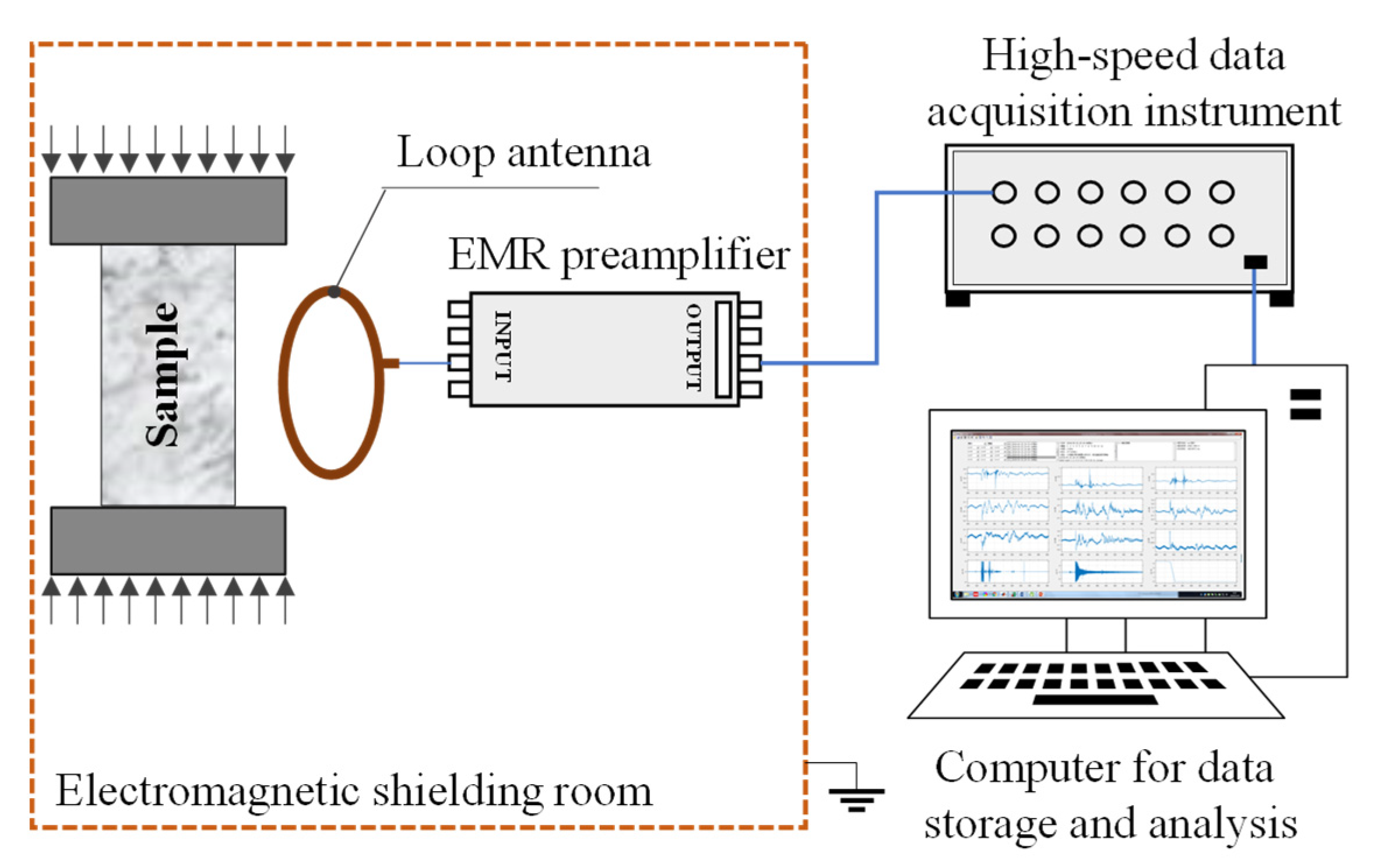
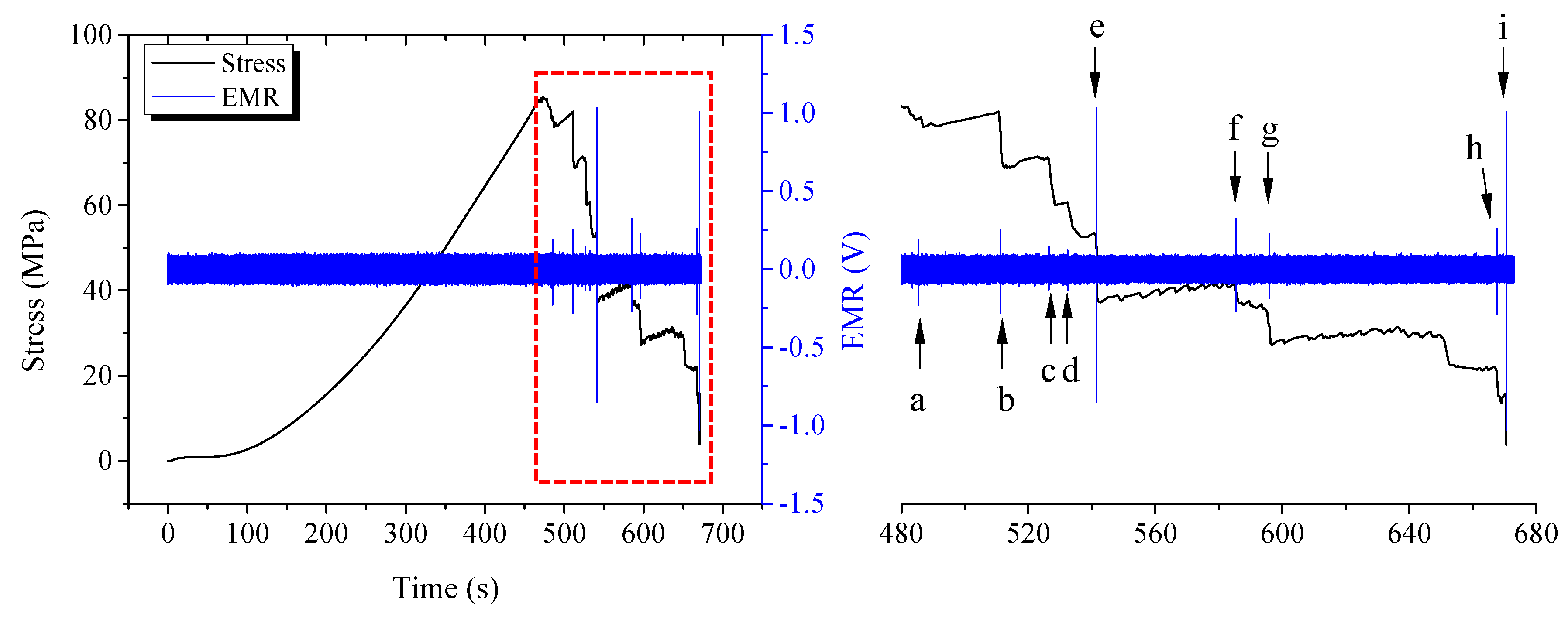
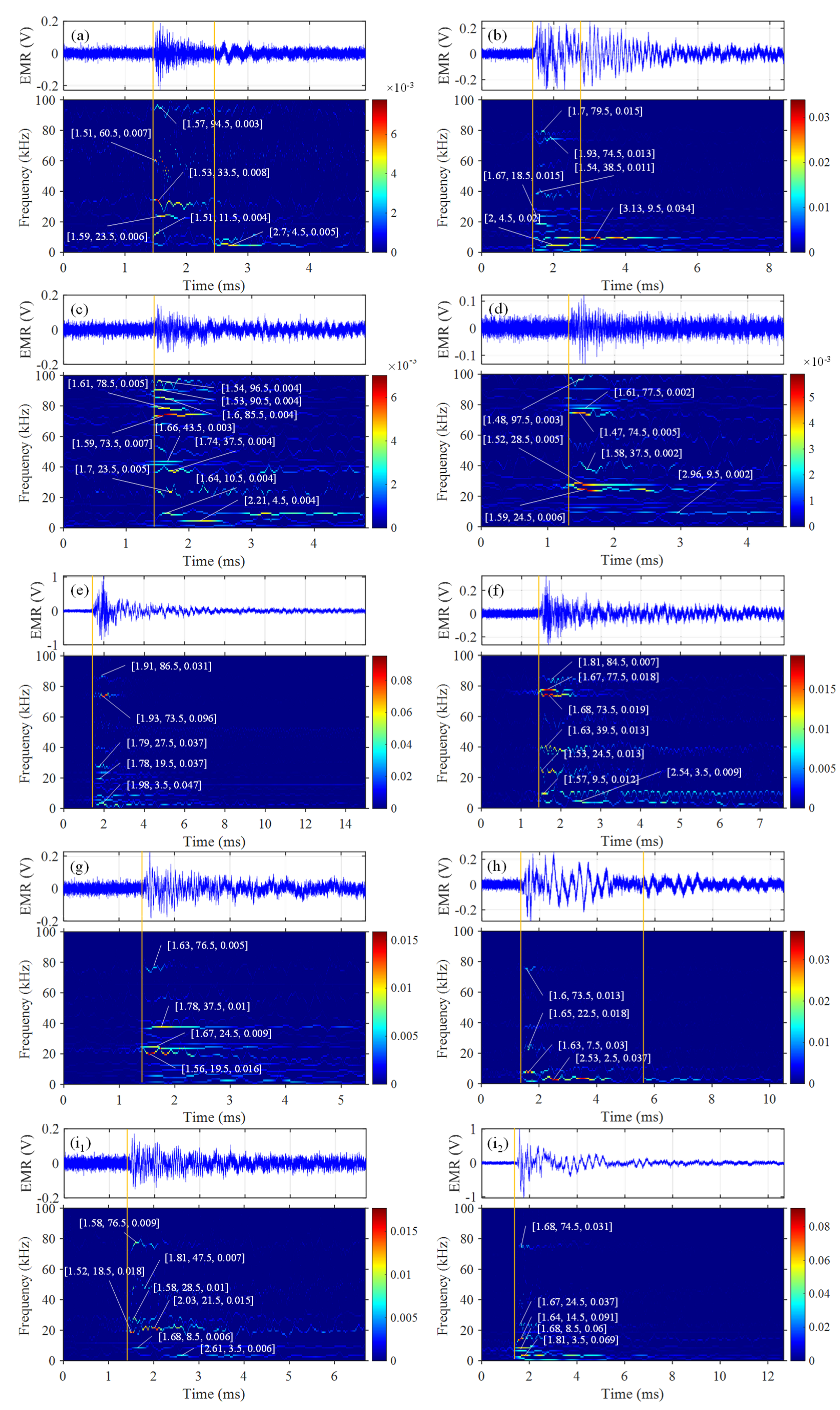
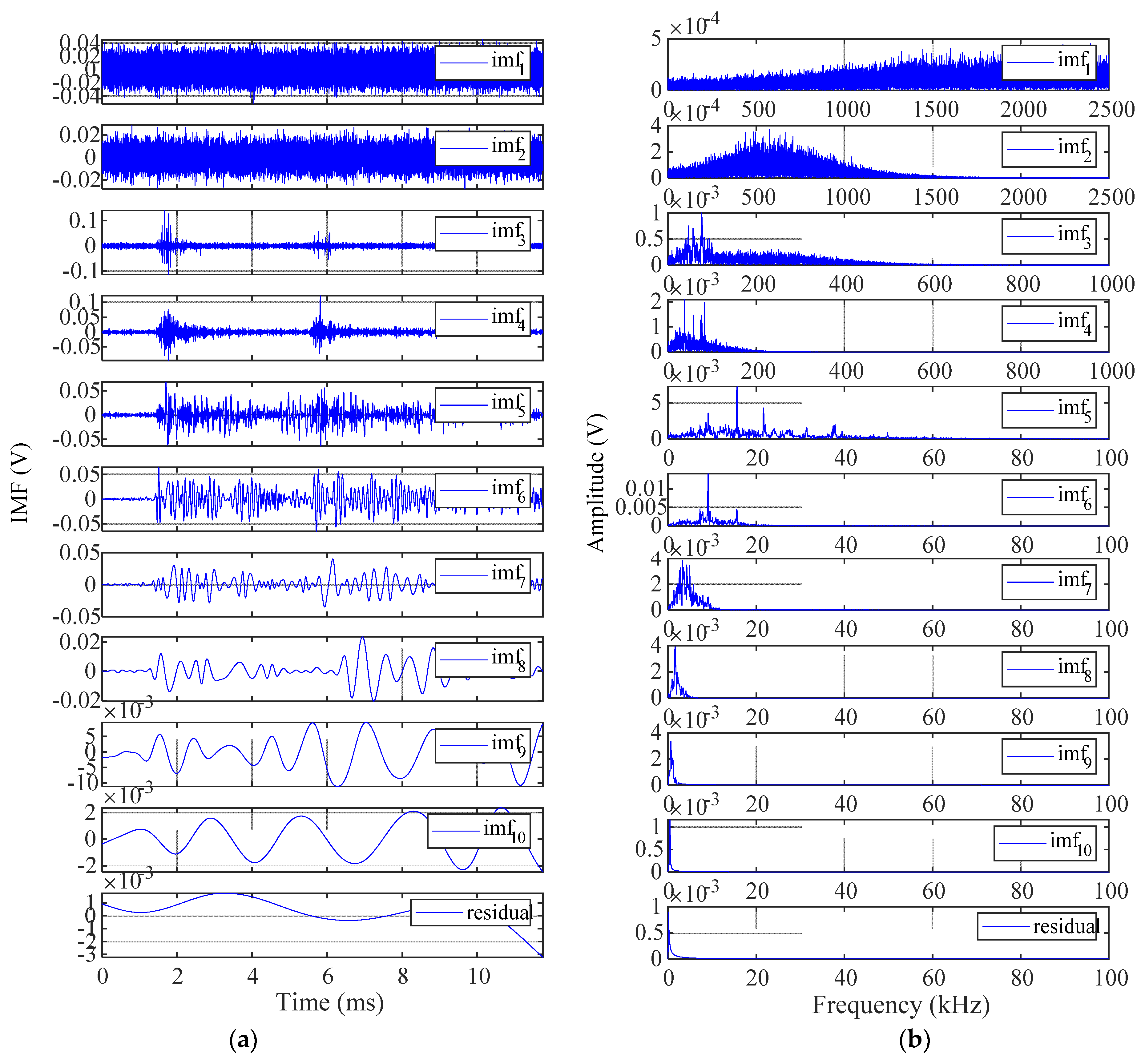
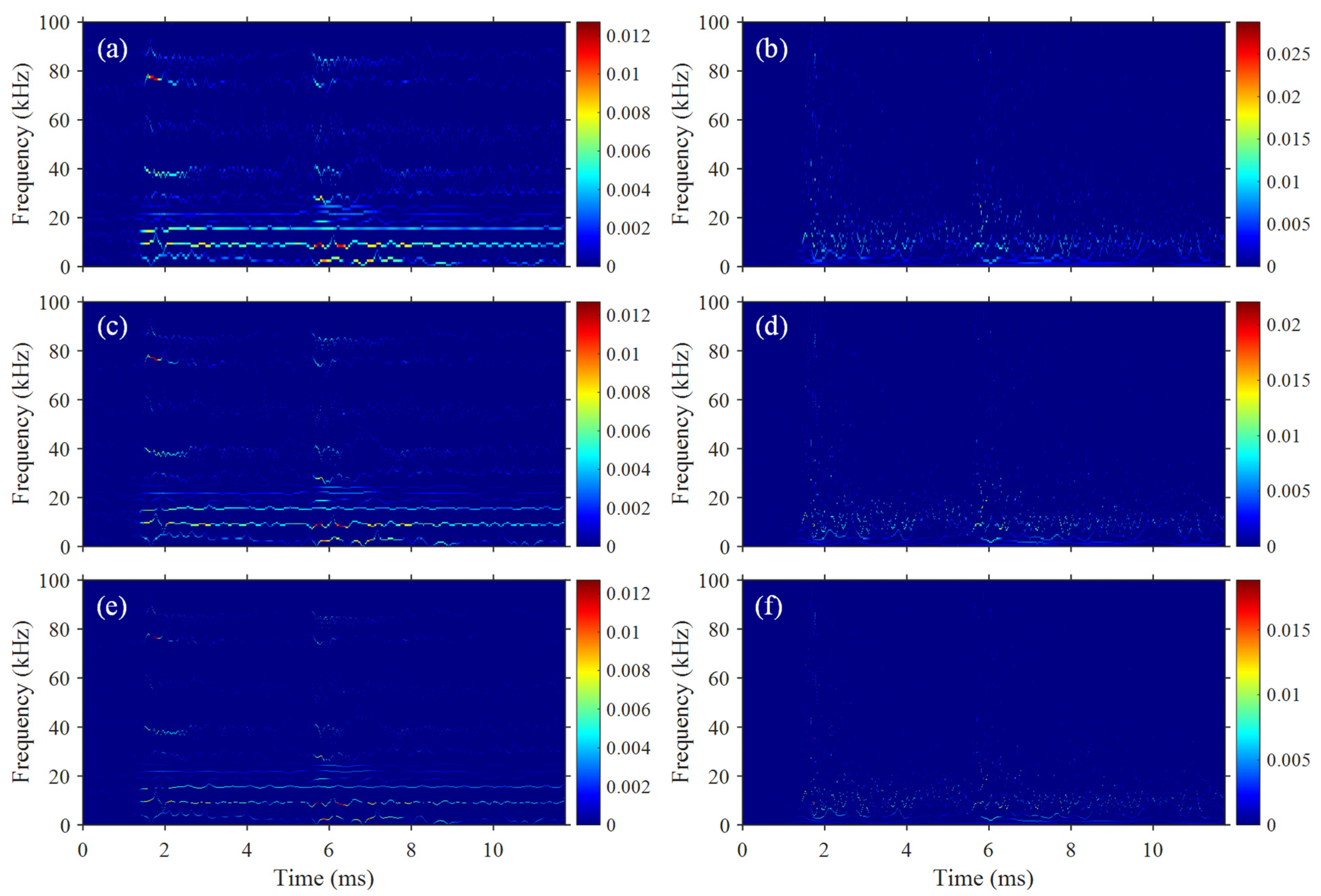

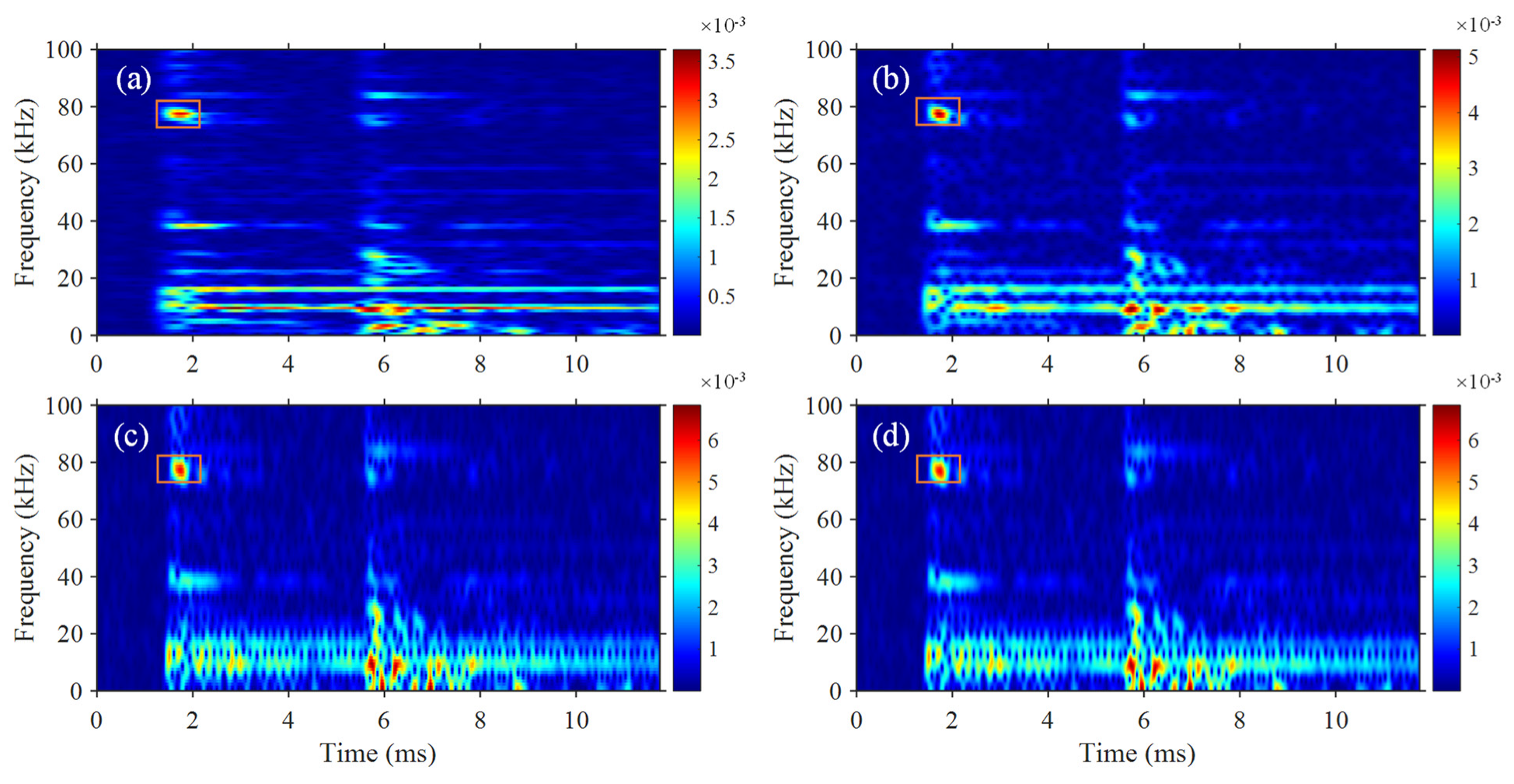
| Waveform No. | Arrival Time (s) | Stress Level (after Peak Stress) | Intensity (V) | Maximum Amplitude (V) | Corresponding Frequency (kHz) |
|---|---|---|---|---|---|
| a | 496.8817 | 94.3% | 0.229 | 0.0077 | 33.5 |
| b | 523.3260 | 95.9% | 0.282 | 0.0339 | 9.5 |
| c | 538.9143 | 83.4% | 0.146 | 0.0070 | 73.5 |
| d | 545.0350 | 71.0% | 0.133 | 0.0059 | 24.5 |
| e | 554.2411 | 62.6% | 1.032 | 0.0953 | 73.5 |
| f | 599.3472 | 47.1% | 0.325 | 0.0193 | 73.5 |
| g | 610.0992 | 41.0% | 0.226 | 0.0159 | 19.5 |
| h | 683.4312 | 25.9% | 0.289 | 0.0369 | 2.5 |
| i1 | 686.4955 | 18.6% | 0.172 | 0.0177 | 18.5 |
| i2 | 686.5054 | 18.6% | 1.033 | 0.0911 | 14.5 |
| imf No. | Frequency Band (kHz) | Intensity (V) | Energy Proportion (%) |
|---|---|---|---|
| imf1 | 0–2500 | 0.0515 | 15.8 |
| imf2 | 0–1500 | 0.0288 | 4.3 |
| imf3 | 0–500 | 0.1409 | 5.8 |
| imf4 | 0–200 | 0.1222 | 9.6 |
| imf5 | 0–70 | 0.0687 | 19.0 |
| imf6 | 0–25 | 0.0651 | 29.8 |
| imf7 | 0–13 | 0.0400 | 9.9 |
| imf8 | 0–7 | 0.0236 | 3.5 |
| imf9 | 0–2 | 0.0111 | 2.2 |
| imf10 | 0–1 | 0.0025 | 0.1 |
Publisher’s Note: MDPI stays neutral with regard to jurisdictional claims in published maps and institutional affiliations. |
© 2022 by the authors. Licensee MDPI, Basel, Switzerland. This article is an open access article distributed under the terms and conditions of the Creative Commons Attribution (CC BY) license (https://creativecommons.org/licenses/by/4.0/).
Share and Cite
Lou, Q.; Wan, X.; Jia, B.; Song, D.; Qiu, L.; Yin, S. Application Study of Empirical Wavelet Transform in Time–Frequency Analysis of Electromagnetic Radiation Induced by Rock Fracture. Minerals 2022, 12, 1307. https://doi.org/10.3390/min12101307
Lou Q, Wan X, Jia B, Song D, Qiu L, Yin S. Application Study of Empirical Wavelet Transform in Time–Frequency Analysis of Electromagnetic Radiation Induced by Rock Fracture. Minerals. 2022; 12(10):1307. https://doi.org/10.3390/min12101307
Chicago/Turabian StyleLou, Quan, Xiangyun Wan, Bing Jia, Dazhao Song, Liming Qiu, and Shan Yin. 2022. "Application Study of Empirical Wavelet Transform in Time–Frequency Analysis of Electromagnetic Radiation Induced by Rock Fracture" Minerals 12, no. 10: 1307. https://doi.org/10.3390/min12101307
APA StyleLou, Q., Wan, X., Jia, B., Song, D., Qiu, L., & Yin, S. (2022). Application Study of Empirical Wavelet Transform in Time–Frequency Analysis of Electromagnetic Radiation Induced by Rock Fracture. Minerals, 12(10), 1307. https://doi.org/10.3390/min12101307






